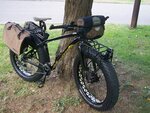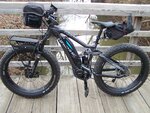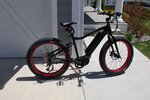Hi Duke! I've been a fatbike convert since buying my
Specialized Fatboy. Here in NJ, my riding is mainly water-level stuff consisting of canal towpaths on either side of the Delaware River working to the north; or to the south, the deep sugar sand roads of the New Jersey Pine Barrens. No mountain side single track with deep drop-offs to your left or right while you are passing a herd of mountain goats here!

What I do have here outside of home, are roadways not maintained by state and local governments; frost heaved, pot-holed, crumbling pieces of asphalt here and there. I had no hesitation of taking my 4.6 inch wide tired Fatboy on my local 20 mile fitness runs to stay in some kind of cardiac fitness standard. When the days grew longer, so did my mileage runs, anywhere from 35 to 75 miles on that Fatboy. And being a first gen Fatboy, a 2015 model, it did not have the type of cassette gearing that the later ones came with, allowing true off-road jeeping behavior.
Looking around on the internet, I came across Court's site here, and his review of the Haibike FatSix and Felt Outfitter. That led to my purchase of a 2017 Haibike Full FatSix and here we are, over 6200 miles later on the Yamaha drive, dual suspensioned fatty and the Fatboy sits, collecting dust in the garage.
To answer some of your questions: My ownership experience for both fatbikes has been the most fun of all the bikes I have ever owned. The whole experience, from the solid stability the wide tire platform gives you, to the noise those tire block treads give you as you are howling along on an asphalt shoulder at 19mph, it was a kick the first time and remains to this day. The dual suspension FatSix absorbs everything our broken road surfaces give me. You will keep up with anybody you ride with on your trails and then some. On the road, you will likely be leading the pack for your friends as you pedal a steady and consistent 16-19 mph. Hills are no longer an issue on the trail or the road, up to the point of your rear tires breaking traction. On this Yamaha drive, you can give your cardiac system as much a workout as anyone else by simply powering down. If you wish to feel like you are 20 again, go to HIGH power. It really is a life changer for us folks who have gotten older by the calendar.
I've got about 4 plus years of Ride Reports with pictures included of my bike rides on both the Fatboy and starting spring 2017, the Full FatSix on a thread titled Fatbiking and Health, located on the MTBR site. I've a lot of posts there on my ride reports, but I think I answer your questions posed here, within the text. Just go to the Fatbikes section and look it up. The Fatbiking and Health thread does not have the haters and trolls that the rest of the mtbr site is known for, so you will feel welcomed and feel at home. Good people on our little thread there, with a vibe that is very much like what I find here on these forums! Here's a link to get ya going. As I mentioned, that thread serves as pretty much a daily recount of my riding on both fatbikes, the Fatboy and Full Fatsix. This particular page is a ride report (including lotsa photos) of my ride from Homebase to Milford, NJ along the canal towpath systems in NJ and PA. That day turned out to be a 95 mile run, all on one full battery charge. Not bad! Link:
https://forums.mtbr.com/fat-bikes/fat-biking-health-922626-63.html
Good luck and welcome to the world of fatbiking!



